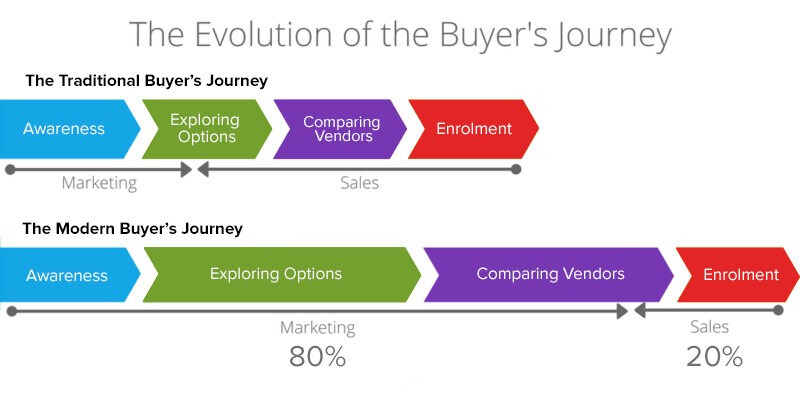Have you ever heard the argument that sales is more important than marketing, or vice versa? It’s common for marketing and sales to be pitted against each other, with one or the other taking priority. Have you ever heard someone say that sales teams are responsible for generating revenue and closing deals, while marketing teams are focused on attracting and nurturing leads? It’s natural to feel like you need to separate these two teams into different focus areas, however, what if we told you that this isn’t the best approach?
Instead of pitting sales against marketing, it is far better to have an aligned approach that allows both teams to work together towards the same goal – growing your business.

As someone who has worked in both sales and marketing, I’ve seen firsthand the benefits of an aligned approach. When sales and marketing teams work together, they can achieve incredible results. Marketing teams can create content that attracts and nurtures leads, while sales teams can use their expertise to close deals and convert those leads into customers. The two approaches may seem different on the surface, but when they’re aligned, they can be incredibly effective.
In this article, you will learn the differences between sales and marketing, why they should be aligned, and how a revenue team can help you achieve this. Whether you’re a small business owner or a marketing or sales professional, this article will provide you with actionable insights to help you grow your business.
So let’s dive in and explore how an aligned approach to sales and marketing can help you achieve your revenue goals.
What’s the Difference Between Sales & Marketing?
To understand why sales and marketing should be aligned, it’s important to first understand what each approach entails and how they differ from one another.
Both sales and marketing involve reaching out to prospects in some way or another in order to move the prospect through the buyer journey and ultimately generate revenue. The key differences between the two is where in the buyer journey they occur and what tactics they use.
1. Where in the buyer journey they occur
Marketing attracts potential buyers, converts them into leads, nurtures these leads so that are more likely to be closed by sales, and helps qualify prospects so that sales doesn’t waste their time with bad-fit prospects. In this way, the majority of marketing activities occur in the first half of the buyer journey.
On the other hand, sales occurs once a lead is qualified. The sales team will handle further nurturing and will bring the prospect from “I’m interested” to “I’m ready to buy”. In this way, sales teams are mostly responsible for the second half of the buyer journey.
While this is true, there is also some overlap. For example, sales teams will use content that marketing has produced in the sales process, and automated emails may be used after a buyer has already become a customer. In this way, one of the differences between marketing and sales is that the majority of marketing activities occur in the first part of the buyer journey and the majority of sales activities occur in the latter part of the journey. However, this rule doesn’t always apply and there tends to be quite a bit of overlap.

While both sales and marketing involves reaching out to and nurturing prospects in order to generate revenue, the point on the buyer journey where each works happens to be different. And this, is one of the main differences between sales and marketing.
2. Tactics that they use
When it comes to marketing, teams might use some of the following tactics to conduct outreach, nurturing and qualifying:
- Paid media
- Content production (blog articles, podcasts, social media marketing)
- One-to-many email nurturing through marketing automations
When it comes to sales, teams might use some of the following tactics to conduct outreach, nurturing, and closing:
- Phone calls/Zoom calls
- SMS
- 1:1 Email
There are many other tactics that teams can use, however these are some of the most common tactics that both teams can utilise. In this way, one of the main differences between sales and marketing is in the tactics that they use.
Which is More Effective? Why an Aligned Approach is Key to Business Growth
While sales and marketing may have different objectives, it’s only when they work together that they can make a real impact on a business’s bottom line. Here are a few reasons why sales and marketing should be aligned:
1. Sales may struggle with having enough prospects to call without marketing
Without marketing, sales teams may struggle to generate enough leads to sustain their efforts. Marketing provides sales teams with a steady stream of qualified leads that they can then convert into customers. By working closely with marketing, sales teams can ensure that they are targeting the right audiences and that their messaging is aligned with the brand’s overall goals.
2. Sales close rates will be far lower and the sales lifecycle far longer without marketing
Without marketing, sales close rates will be lower and the sales lifecycle will be far longer. By using content that marketing has created in the sales process, sales reps can dramatically increase close rates and shorten the sales cycle. Sales reps can utilise Assignment Selling, a tactic that involves assigning “homework” in the form of educational blog articles to buyers in order to answer their most pressing questions.
Research has shown that sales close rates can improve from 15-20% up to 80% by using this approach, and that the length of the sales lifecycle decreases significantly through this approach. However, without the help of marketing, sales would not have content to use for Assignment Selling.
3. Marketing is ineffective without sales
While marketing can generate interest and awareness, it’s ultimately up to the sales team to close deals and generate revenue. Without a strong sales team, marketing efforts may fall flat, as there’s no one there to convert leads into customers.
4. Marketing may produce irrelevant and unhelpful content without sales
By working closely with sales, marketing teams can ensure that they are creating content that answers buyer questions. Too often we find that marketing teams sit in their ivory towers and produce content that they think buyers want to read, but that doesn’t answer buyers’ questions and is ultimately unhelpful in closing deals.
However, when sales works with marketing, they can share what questions real prospects are asking on sales calls, so that content can be produced to answer these questions. By answering buyer questions transparently and accurately, you can become a trusted advisor and ultimately close more deals. However, without the help of sales, marketing may struggle to produce content for this purpose.
5. Aligned teams can generate more revenue

When sales and marketing teams are aligned, they can work together to generate more revenue for the business. By sharing insights and data, they can identify opportunities for growth and create campaigns that target specific audiences and drive conversions. They can also ensure that the customer journey is seamless and consistent, from the initial marketing touchpoint to the final sales transaction.
In summary, sales and marketing should be aligned because they are both critical to the success of a business, and it’s only when they work together that they can achieve long-term growth. Rather than thinking about “sales vs marketing”, you should be thinking about “how can my sales and marketing teams better work together?”
In the next section, we’ll explore what it looks like when sales and marketing teams are aligned, and how it can benefit your business.
Why Revenue Teams are the Answer
To fully align your sales and marketing efforts, you may want to consider creating a revenue team.
A Revenue Team is a combination of your sales and marketing teams and is made up of key players from both sales and marketing. All activities, regardless of individual roles, are focused on the shared goal of increasing company revenue.
The main purpose of the Revenue Team is exactly what you might suspect – to increase company revenue. Revenue Teams are the answer because they’re the perfect way to effectively align marketing and sales. Without the Revenue Team, you might find it extremely difficult to align these two teams.
But how exactly does the Revenue Team go about aligning marketing and sales for business growth?
The day-to-day operations of a revenue team include these core recurring activities:
- Weekly or fortnightly revenue team meetings where they discuss the content that has been published and its value, the content that is currently in production, and the performance of previous content for sales.
- Brainstorming sessions to come up with new content ideas by answering questions such as “What do your buyers have the biggest doubts or worries about?”
- Measuring the quality of sales enablement content by asking follow-up questions such as “Why are they asking this question?” and “When are they asking this question in the sales process?”
- Fortnightly Team Reports to update the team on what was done last and what’s next.
- Monthly Newsletter to showcase content wins and sales wins from the efforts of the Revenue Team.

If you want to find out more about how to implement a Revenue Team in your business, read this article.
Marketing vs Sales Final Verdict
In this article, you learnt the differences between sales and marketing, and why it’s important to align these two departments for long-term business growth. We’ve discussed how sales is ineffective without marketing, and how marketing is ineffective without sales. We’ve also explored what it looks like when sales and marketing teams work together, including the practice of assignment selling, creating marketing content from sales ideas, and the formulation of Revenue Teams to support these.
So, what’s the final verdict – is sales or marketing better to focus on in your business for growth?
Well, competing between sales and marketing is not the answer. Instead, an integrated approach is key, where both sales and marketing can work together to drive revenue growth. And the way to do this is to formulate a Revenue Team. So, the answer is that neither marketing or sales is better, but that both need to work together for maximum success.
If you want to better align marketing and sales in order to drive revenue growth, then you’re probably going to want to get more familiar with ‘They Ask, You Answer’, a marketing and business framework that helps you align both teams for success.












